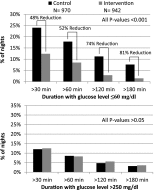A randomized trial of a home system to reduce nocturnal hypoglycemia in type 1 diabetes
- PMID: 24804697
- PMCID: PMC4067393
- DOI: 10.2337/dc13-2159
A randomized trial of a home system to reduce nocturnal hypoglycemia in type 1 diabetes
Abstract
Objective: Overnight hypoglycemia occurs frequently in individuals with type 1 diabetes and can result in loss of consciousness, seizure, or even death. We conducted an in-home randomized trial to determine whether nocturnal hypoglycemia could be safely reduced by temporarily suspending pump insulin delivery when hypoglycemia was predicted by an algorithm based on continuous glucose monitoring (CGM) glucose levels.
Research design and methods: Following an initial run-in phase, a 42-night trial was conducted in 45 individuals aged 15-45 years with type 1 diabetes in which each night was assigned randomly to either having the predictive low-glucose suspend system active (intervention night) or inactive (control night). The primary outcome was the proportion of nights in which ≥1 CGM glucose values ≤60 mg/dL occurred.
Results: Overnight hypoglycemia with at least one CGM value ≤60 mg/dL occurred on 196 of 942 (21%) intervention nights versus 322 of 970 (33%) control nights (odds ratio 0.52 [95% CI 0.43-0.64]; P < 0.001). Median hypoglycemia area under the curve was reduced by 81%, and hypoglycemia lasting >2 h was reduced by 74%. Overnight sensor glucose was >180 mg/dL during 57% of control nights and 59% of intervention nights (P = 0.17), while morning blood glucose was >180 mg/dL following 21% and 27% of nights, respectively (P < 0.001), and >250 mg/dL following 6% and 6%, respectively. Morning ketosis was present <1% of the time in each arm.
Conclusions: Use of a nocturnal low-glucose suspend system can substantially reduce overnight hypoglycemia without an increase in morning ketosis.
Trial registration: ClinicalTrials.gov NCT01591681.
© 2014 by the American Diabetes Association.
Figures



References
-
- Bergenstal RM, Klonoff DC, Garg SK, et al. ASPIRE In-Home Study Group Threshold-based insulin-pump interruption for reduction of hypoglycemia. N Engl J Med 2013;369:224–232 - PubMed
Publication types
MeSH terms
Substances
Associated data
Grants and funding
LinkOut - more resources
Full Text Sources
Other Literature Sources
Medical

